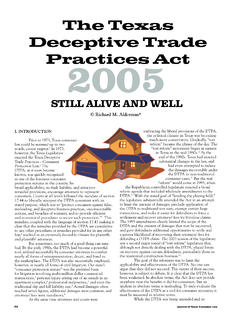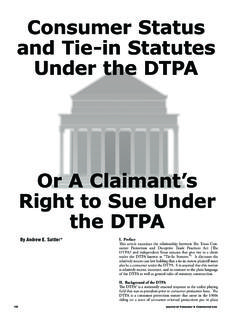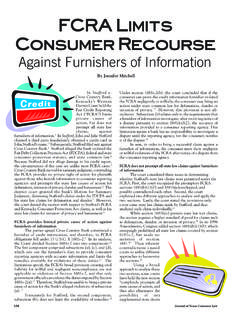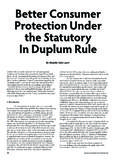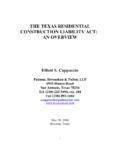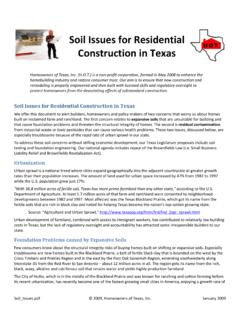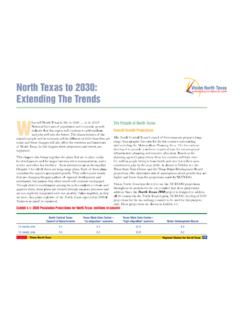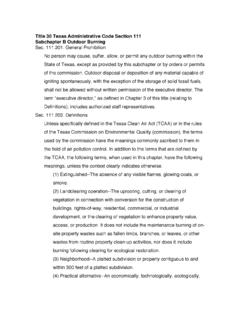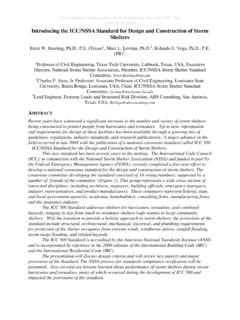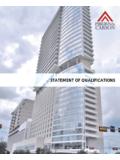Transcription of And the New Residential Construction Commission …
1 Journal of texas Consumer Law13I. INTRODUCTIONThe Residential Construction Liability Act1( RCLA ) was enacted by the texas Legislature in1989 for the stated purpose of restoring a fair andappropriate balance to the resolution of residentialconstruction disputes between contractors andowners. Homebuilders and home warrantycompanies argued that contractors should have anopportunity to cure Construction defects before beingsubjected to the monetary settlement provisions ofthe texas Deceptive Trade Practices ConsumerProtection Act2 ( DTPA ). By limiting ahomeowner s damages in certain, specificcircumstances, the RCLA was intended to encouragethe resolution of Construction disputes and to protectand reward responsive contractors who timely fixedtheir , the RCLA made sense.
2 HomesThe Residential Construction Liability Act New ResidentialConstructionCommissionby Cheryl Turner*And theare a large and emotional purchase for most consumers, so encouraging homeowners and contractors tofix the home rather than engage in protracted litigation is a laudable goal. When the RCLA wasenacted in 1989, consumer advocates embraced the concept of an opportunity to cure, so long ashomeowners still had the protections of the DTPA when builders did not make reasonable attempts tofix the home and settle the , despite the avowed purpose of builder lobbyists to foster balance in theresolution of Construction disputes, such builder lobbyists and advocates have, at nearly everylegislative session since the RCLA was passed, attempted to redesign it to further restricthomeowner rights.
3 The laudatory words of the RCLA s proponents belie their intent to createblatant special interest legislation that would protect good and bad builders the 2003 Legislature, the builders finally realized the fruits of their well-funded lobbyingefforts. Despite the fact that homeowners with serious Construction defect claims against their buildersalready faced nearly impossible odds of ever being made whole, a new and labyrinthine set of procedureswas enacted to all but bar the courthouse door to aggrieved homeowners. Although the RCLA is stillthe statute that governs the remedies available in Residential Construction defect disputes, homeownerswith complaints against a contractor will now be required to submit their claim to the newly formedTexas Residential Construction Commission ( TRCC or Commission ) before triggering the builder sJournal of texas Consumer Law14right to cure.
4 The homeowner s obligation to make hisclaim before the Commission is a prerequisite to filing alawsuit or even a claim in arbitration. Section II of thisarticle will discuss the new texas Residential one minor exception, there were no publishedopinions on the RCLA for the first eight years after it However, in 1997-98 three courts of appeals issuedopinions interpreting significant portions of the RCLA. Thefirst was the much-anticipated decision in O Donnell v. RogerBullivant of texas , The second was the controversialopinion in Bruce v. Jim Walters Homes, The third wasthe opinion In re Kimball Hill Homes texas , Despitethese first opinions, there remained numerous unansweredquestions, and trial courts continued to make contradictoryrulings on the application of the RCLA.
5 Since these decisions,other significant decisions have been issued that have helpedclarify this practice area, including Sanders v. ConstructionEquity, Inc.,7 and what many practitioners consider to be themost important case issued to date: Perry Homes v. these cases still govern causes of action that accruedprior to September 1, 2003, it remains to be seen how thesecases will be applied when the new law takes continuing lack of predictability in the courts, nowcoupled with a dense and confusing new set of state-mandatedprocedures, ensures that Residential Construction disputes willremain complex and costly for both contractors andhomeowners.
6 The specific provisions of the RCLA and manyof the open questions are examined below in Section III. Themost important court decisions are discussed at length inSection THE texas Residential CONSTRUCTIONCOMMISSION ACTA. Scope of the TRCCAThe texas Residential Construction Commission Act9( TRCCA or Act ), is an ambitious piece of legislationthat covers almost every aspect of Residential general, the TRCCA creates a Commission (the TRCC)to oversee the Residential Construction industry and carry outthe following acts: Manage a mandatory pre-suit, state-sponsoredinspection and dispute resolution process for claimsbetween a homeowner and contractor.
7 The processis a prerequisite to filing a lawsuit or demand forarbitration; Establish warranty and building performancestandards applicable to all new home Construction ; Maintain a public website with information aboutthe role of the Commission , the warranty standardsand the dispute resolution process; Maintain records of complaints againsthomebuilders; Establish and maintain mandatory registrationprocedures for builders; Establish eligibility requirements for certification asa Residential Construction arbitrator; Impose administrative penalties on registeredbuilders and certified arbitrators who violate TRCC rules; Establish procedures for the registration of each newhome with the Commission ; Establish eligibility requirements for and employstate inspectors; Appoint a mold reduction task force; Appoint a task force to develop Residential designrecommendations that encourage rain harvestingand water recycling; Approve third-party warranty companies; Appoint a Residential Construction arbitration taskforce; Establish rules for the filing of arbitration awardswith the Commission .
8 And Collect fees lots of Subtitle D: State-Sponsored Inspection and DisputeResolution ProcessAlthough the above list shows the incredible scope ofthe TRCCA, for persons involved in Residential constructiondefect claims, there are two important aspects of the Act thatbear closer examination: the dispute resolution process andthe creation of warranty and building THE RELATIONSHIP OF THE TRCCA TO THERCLAAs the RCLA was a set of procedures that homeownershad to go through before filing a lawsuit under the DTPA,the TRCCA is a set of procedures that most (but not all)homeowners will have to go through before proceeding withthe opportunity to cure provisions of the RCLA.
9 As explainedmore fully below, not all RCLA claims will be subject to theTRCCA because the RCLA s scope is more expansive thanthat of the the TRCCA applies, section providesthat homeowners must submit claims against their buildersto the dispute resolution process before initiating anaction for damages or other relief arising from an allegedconstruction THE DISPUTE RESOLUTION PROCESS Dispute resolution is surrounded by quotation marksin this article and with good reason: the Commission doesnot resolve disputes between homeowners and does, however, establish a process that now applies to nearlyevery dispute between a homeowner and a contractor.
10 Assuch, it resembles administrative exhaustion, with one keyexception the Commission does not have the power toissue ) What kind of disputes are governed by the TRCC?The substance of the dispute resolution process isset out in Subtitle D of the TRCCA, a full twenty-fivesections into the Act. This subtitle applies to a disputebetween a builder and a homeowner if the dispute arisesout of an alleged Construction defect. 10 While seeminglystraightforward, the terms builder, homeowner, and Construction defect are defined terms that, when puttogether, create an ambiguous meaning that is likely toconfuse both homeowners and definition of a builder is found in section ,and it differs from that of a contractor found in the the RCLA, a builder under the TRCCA includes newhomebuilders, most remodelers, and home warrantycompanies that insure all or part of a builder s liability forconstruction defects.
